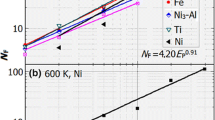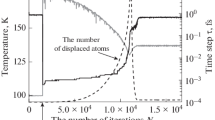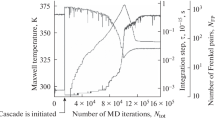Abstract
Molecular dynamics simulations of energetic displacement cascades in Cu and Ni were performed with primary-knock-on-atom (PKA) energies up to 5 keV. The interatomic forces were represented by the Gibson II (Cu) and the Johnson-Erginsoy (Ni) potentials. Our results indicate that the primary state of damage produced by displacement cascades is controlled basically by two phenomena: replacement collision sequences during the ballistic phase, and melting and resolidification during the thermal spike. The thermal-spike phase is of longer duration and has a more marked effect in Cu than in Ni. Results for atomic mixing, defect production, and defect clustering are presented and compared with experiment. Simulations of “heat spikes” in these metals suggest a model for “cascade collapse” based on the regrowth kinetics of the molten cascade core.
Similar content being viewed by others
References
See, e.g., V. M. Agranovich and V. V. Kirsanov, in Physics of Radiation Effects in Crystals, edited by R. A. Johnson and A. N. Orlov (Elsevier, New York, 1986), p. 117.
Proceedings of Workshop on Fusion Materials, Lugano, Switzerland, May 1988 (published in Radiation Effects, in press).
See, e.g., Mat. Res. Soc. Symposia Proceedings 51 (1986), 74 (1987).
J. R. Beeler, Jr., Phys. Rev. 150, 470 (1966).
M. T. Robinson and I. M. Torrens, Phys. Rev. B 9, 5008 (1974).
G. H. Vineyard, Rad. Effects 29, 245 (1976).
J. B. Gibson, A. N. Goland, M. Milgram, and G. H. Vineyard, Phys. Rev. 120, 1229 (1960).
W. E. King and R. Benedek, J. Nucl. Mater. 117, 26 (1983); Phys. Rev. B 23, 6335 (1981).
R. A. Johnson, Phys. Rev. 145, 423 (1966); C. Erginsoy, G. H. Vineyard, and A. Englert, Phys. Rev. 133, A595 (1964). See also the comments on this potential by J. R. Beeler, Jr., in Radiation Effects Computer Experiments (North-Holland, New York, 1982), p. 129.
P. H. Dederichs, C. Lehmann, H. R. Schober, A. Scholz, and R. Zeller, J. Nucl. Mater. 69/70, 176 (1978).
Melting temperatures were estimated from simulations with Rahman-Parrinello boundary conditions and external pressures of 62.9 kbar and 202.4 kbar, for the Johnson-Erginsoy and Gibson II potentials, respectively, which reproduce the appropriate room-temperature lattice constants. A cell with 576 atoms is first equilibrated at a given temperature and then “seeded” either with a vacancy cluster (up to 19 vacancies) or with several vacancies in a local region; the structure factor is monitored to determine whether melting occurs. We note, however, that this procedure provides only an upper bound on the melting temperature if superheating occurs (J. F. Lutsko, S. R. Phillpot, and D. Wolf, personal communication). The cluster sizes employed are probably large enough to nucleate effectively a melt and minimize superheating effects.
M. W. Finnis and J. E. Sinclair, Philos. Mag. A 50, 45 (1984).
M. S. Daw and M. Baskes, Phys. Rev. B 29, 6443 (1984).
The pair distribution function g(r) is calculated for a spherical region of radius Rgi(t), the radius of gyration of the distribution of “interstitial” atoms at time t. A more precise definition of the disordered region could be devised, but the qualitative features of g(r) would be unchanged.
S. Foiles, Phys. Rev. B 32, 3409 (1985).
The center of the cascade is defined here as the centroid of the vacancy distribution at an early time in its development (t = 0.1 ps).
The experimental values of Tm were used.
S.-J. Kim, M-A. Nicolet, R. S. Averback, and D. Peak, Phys. Rev. B 37, 38 (1988).
R. S. Averback, R. Benedek, and K. L. Merkle, Phys. Rev. B 18, 4156 (1978).
P. Jung, J. Nucl. Mater. 117, 70 (1983).
K. L. Merkle, in Radiation Damage in Metals, edited by N. L. Peterson and S. D. Harkness (American Society for Metals, Metals Park, OH, 1976), p. 58.
M. W. Guinan and J. H. Kinney, J. Nucl. Mater. 103/104, 1319 (1981).
C. Y. Wei, M. I. Current, and D. N. Seidman, Philos. Mag. 44, 459 (1981).
D. Pramanik and D. N. Seidman, Nucl. Instr. and Meth. 209/210, 453 (1983).
D. Grasse, B. v. Guerard, and J. Peisl, J. Nucl. Mater. 120, 304 (1984).
C. A. English and M. L. Jenkins, Mats. Science Forum 15–18, 1003 (1987).
M. A. Kirk, I. M. Robertson, M. L. Jenkins, C. A. English, T. J. Black, and J. S. Vetrano, J. Nucl. Mater. 149, 21 (1987).
V. I. Protasov and V. G. Chudinov, Rad. Eff. 66, 1 (1982).
V. G. Kapinos and P. A. Platonov, Rad. Eff. 103, 45 (1987).
P. M. Richards, Phys. Rev. B 38, 2727 (1988).
E. Burke, J. R. Broughton, and G. H. Gilmer, J. Chem. Phys. 89, 1030 (1988).
K. Smalinskas, I. M. Robertson, and R. S. Averback (unpublished) and K. Smalinskas, Master’s Thesis, University of Illinois at Urbana, 1988.
C. P. Flynn and R. S. Averback, Phys. Rev. B 38, 7118 (1988); see also Z. Sroubek, Appl. Phys. Lett. 45, 849 (1984).
J. Lindhard, M. Scharff, and H. E. Schiøtt, Mat. Fys. Medd. Dan. Vid. Selsk. 33, No. 14, 1963.
T. E. Faber, in Physics of Metals I., Electrons, edited by J. M. Ziman (Cambridge University Press, Cambridge, 1969), p. 284.
Author information
Authors and Affiliations
Rights and permissions
About this article
Cite this article
de la Rubia, T.D., Averback, R.S., Hsieh, H. et al. Molecular dynamics simulation of displacement cascades in Cu and Ni: Thermal spike behavior. Journal of Materials Research 4, 579–586 (1989). https://doi.org/10.1557/JMR.1989.0579
Received:
Accepted:
Published:
Issue Date:
DOI: https://doi.org/10.1557/JMR.1989.0579




